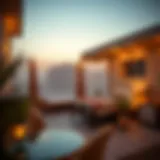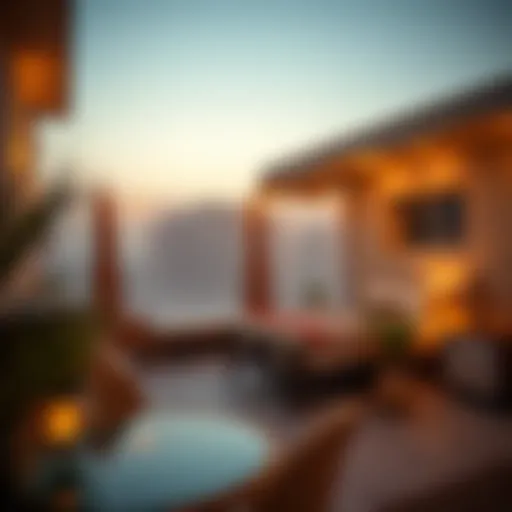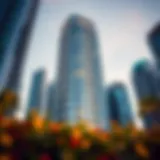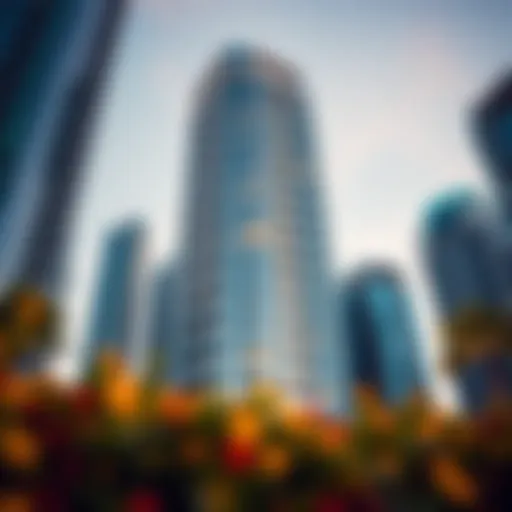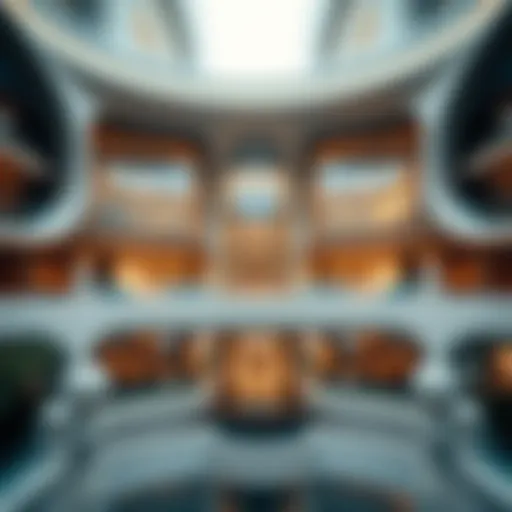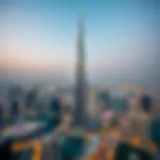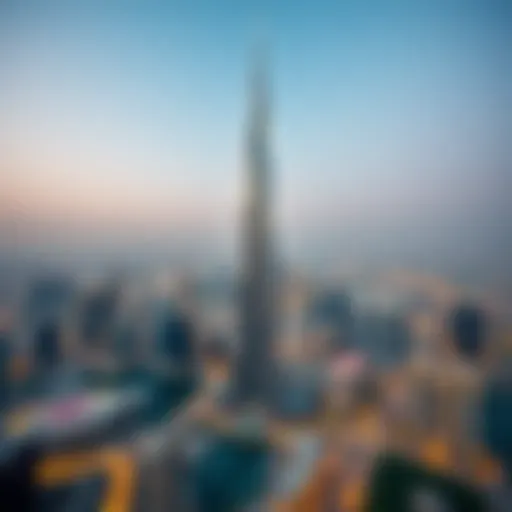The Clock Tower: A Historical Perspective in Dubai
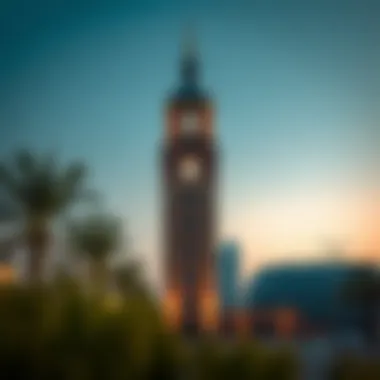

Intro
The Clock Tower in Dubai stands tall as not only an indicator of time but also as a symbol of the city’s rich tapestry of history and culture. Positioned at a busy roundabout in Deira, this iconic structure has become a focal point that reflects the melding of tradition and modernity. While skyscrapers rise and the desert sun beats down on the bustling streets, the Clock Tower remains a quiet sentinel, watching over the city's evolution since its establishment in the late 1960s.
The story of the Clock Tower is not simply about bricks and mortar; it’s woven into the very fabric of Dubai. The unique blend of various architectural influences was envisioned to embody both the aspirations and the realities of a rapidly developing metropolis. In this article, we will dissect the historical framework surrounding the Clock Tower, exploring its architectural elements and discussing the influential role it plays within Dubai's urban layout.
This exploration will provide clarity on how such structures contribute significantly not just to the skyline but also to the social identity of its residents and visitors alike. Key themes include the dynamic interplay between contemporary architecture and traditional culture, elucidating how the Clock Tower stands as a monument of time, marking the progression of a vibrant community.
Join us as we delve deeper into the intricate layers surrounding the Clock Tower, its significance in both the past and present, and its implications for Dubai's future.
Preamble to the Clock Tower
The Clock Tower stands as a bastion of Dubai's rich history and urban evolution. It serves not merely as a timepiece but as a landmark of sentimental resonance and architectural prowess. The importance of this structure stretches beyond its physical presence; it encapsulates the various cultural and historical shifts in this metropolis. Here, we embark on a exploration of the significance of the Clock Tower in how it intertwines with Dubai’s urban landscape.
Overview of its Historical Importance
Initially erected during the golden years of Dubai's transformation, the Clock Tower was built in 1975. Its establishment coincided with the nation’s ambitious journey toward modernization and development. The tower is more than just a beautiful piece of architecture; it’s a memorial to the aspirations of a young nation eager to carve its own identity on the global stage.
As one heads down Al Maktoum Street, the Clock Tower attracts attention with its intricate design and bright colors, almost like a lighthouse guiding the way through the bustling city life. The local population often refer to it as a meeting point, a spot where both the young and elderly exchange stories, reminiscences tied to the growth of this city.
The Clock Tower embodies the collective experiences of Dubai’s inhabitants and their shared heritage. Its construction reflects the emirate's leap towards globalization, showcasing the balance of preserving tradition while embracing modernity. Each stroke of its hands narrates a story - tales of socioeconomic advancements, cultural melting pots, and technological innovations.
Symbolism in Dubai's Urban Landscape
In the heart of Dubai, the Clock Tower acts as a symbolic anchor amidst the rapidly developing urban landscape. It's a visual representation of the bridge between historical reverence and contemporary living. As skyscrapers tower around it, the Clock Tower stands tall, a testament to the city’s resilience and growth.
Visually striking, the high-reaching towers surrounding it may symbolize aspirations, yet the Clock Tower represents stability and continuity. For many residents, it serves as a reminder of where the city started: a small fishing village that blossomed into a global hub.
The Clock Tower is also emblematic of the city’s unique identity. Unlike the typical western-style clocks found in many metropolises, it integrates elements from Arabic architecture, showcasing local artistry that resonates with both the past and present. It stands not just as a timekeeper but as a cultural artifact that captures the essence of Dubai's multicultural narrative.
In summary, the Clock Tower is steeped in historical context and adopts symbolic significance within Dubai's urban landscape. It serves as a touchstone for city-dwellers, reminding them of their roots while also highlighting their current living dynamics in a vibrant, ever-evolving city.
Historical Context
Understanding the historical context of the Clock Tower is essential for grasping its significance within Dubai's urban landscape. The timeline of its construction, along with the socio-cultural dynamics at play during its inception, sheds light on how this remarkable structure became a pivotal landmark. The evolution of the structure reflects broader trends and transformations in Dubai itself, serving as a physical representation of its journey from a modest fishing village to a bustling metropolis.
Origins and Construction
The Clock Tower was erected in the early 1960s, a period marked by rapid development in Dubai. The need for a central point to signify the city’s evolving identity became imperative. Designed by architect Abdul Rahman Makhlouf, the clock was not merely an architectural addition but a statement of ambition. Built using locally sourced materials, its early construction faced multiple challenges ranging from limited resources to the harsh desert climate.
The project began with obtaining the necessary permits from the local government, which recognized its significance. Interestingly, public participation played a role; local citizens were eager to contribute, underscoring a collective desire for modernity and progress. The Clock Tower's structure, completed in 1964, elegantly combined traditional Islamic motifs with modernist influences, capturing the spirit of the time.
With its towering height of thirty-eight meters, the Clock Tower became a prominent feature amidst Dubai’s skyline. It stands at the intersection of Sheikh Zayed Road and Al Maktoum Road, symbolizing the intersection of past and future. The large clock faces, visible from afar, serve as a functional aspect, reinforcing the importance of time in this rapidly changing society.
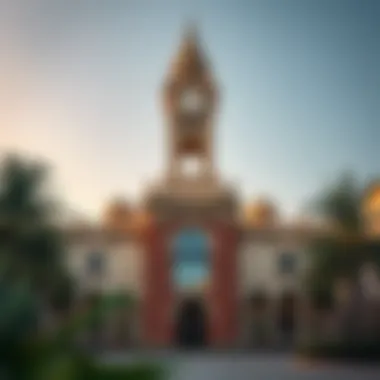

Influence of Cultural Shifts
The emergence of the Clock Tower coincided with significant cultural shifts within Dubai. With oil discoveries reshaping the economy during the late 20th century, the city became a melting pot of cultures, attracting expatriates and businesses from around the globe. This transformation was not without its conflicts, as traditional values often clashed with modern aspirations.
As a result, the Clock Tower became more than a timepiece; it evolved into a symbol of unity, bringing together various communities. Various events, such as National Day celebrations and other festivities, have utilized the Clock Tower as a backdrop, just as a blackboard serves to display important teaching points. Local artists and cultural institutions have paid tribute to this landmark, integrating it into art and literature, further solidifying its role in the social fabric of the city.
Moreover, the Clock Tower marked the onset of large-scale urban projects, ushering in an era of transformation that would lead to iconic structures such as Burj Khalifa and the Dubai Mall. The shift evident in the clock’s inception is a testament to the adaptable and forward-looking nature of Dubai, which embraces progress while respecting its roots.
“The Clock Tower is not just an object; it is a canvas that reflects our time and culture, speaking volumes about our aspirations.”
In summary, the Clock Tower encapsulates a crucial chapter in Dubai's growth. Understanding its origins and the cultural shifts surrounding its construction helps us appreciate its significance in the larger narrative of Dubai's urban landscape.
Architectural Features
Dubai's Clock Tower is more than just a timekeeping instrument; it stands as an architectural emblem in the city’s constantly evolving landscape. It encapsulates both the aspirations and the cultural identity of Dubai, blending traditional elements with modern twists. Understanding its architectural features is crucial, as they reveal the underlying thought processes that shaped not just the Clock Tower, but also the broader urban environment it sits in.
Design Elements and Structure
The design of the Clock Tower incorporates various elements that reflect both functionality and elegance. Upon first glance, one may note the structure's symmetrical form, which is essential in creating a feel of balance in the midst of a bustling urban setting. The tower ascends sharply, like a monumental finger pointing towards the sky, symbolizing Dubai's ambitious skyline.
The inclusion of balconies is an intriguing aspect, not only providing aesthetic appeal but also serving as viewing points that engage visitors with the surrounding area. You may notice that the clock itself is positioned at an impressive height, ensuring that its face is visible from multiple vantage points across the city.
The interplay of geometric shapes within the structure creates visual rhythm; circles mingle with squares, adding to the dynamic feel. This design decisions are grounded in an understanding of how people move through urban spaces. Recognizing that city dwellers often seek landmarks as points of reference, this structural design enhances navigation within the city, anchoring Dubai's residents and visitors alike.
Materials and Craftsmanship
The materials used in the construction of the Clock Tower also warrant attention. A blend of concrete and steel reinforces the durability of the structure, allowing it to withstand the changing elements of Dubai's weather. This choice reveals a practical approach, reflected in the meticulous crafting of every component.
Additionally, elements such as glass are thoughtfully included, enhancing natural light and providing a luminous quality to the tower, which almost seems to glow when illuminated at night. It is not just a matter of beauty; these materials resonate with the modern identity of Dubai, reflecting the energy and chaos of urban life while ensuring that the historical fabric remains intact.
Artisans' expertise is evident, particularly in the ornate detailing seen in the clock's sections—the intricate engravings showcasing master craftsmanship. Such dedication to detail avoids that cookie-cutter feel often associated with modern constructs, anchoring the Clock Tower firmly in its heritage.
Cultural Significance
The Clock Tower stands as more than just a physical structure in Dubai; it symbolizes the heartbeat of the city and its people. In a metropolis known for its rapid evolution, this iconic landmark encapsulates a rich tapestry of cultural narratives that bridge both tradition and modernity. The significance of the Clock Tower is woven into the daily lives of Dubai's residents and its visitors, resonating deeply within the urban landscape.
A Gathering Point for the Community
Over the years, the Clock Tower has evolved into a pivotal gathering point for both locals and tourists. Not merely a place to check the time, it fosters a sense of community among Dubai's diverse population. People from all walks of life converge around the tower, sharing stories, laughter, and cultural experiences. Its strategic location at the intersection of major thoroughfares makes it a natural meeting ground, attracting those who seek connection in a bustling urban environment.
Local events often transpire around this landmark. Festivals and public gatherings showcase the rich tapestry of Emirati culture, with traditional music, food, and art. Here, you might find families picnicking in its vicinity or school children learning about their city's heritage as they observe the landmark's grandeur. This communal aspect imbues the Clock Tower with a living, breathing identity that evolves with each passing day.
Community engagement is vital; through it, the Clock Tower nurtures social bonds and fosters a sense of belonging among the diverse populace of Dubai.
Artistic Representations and References
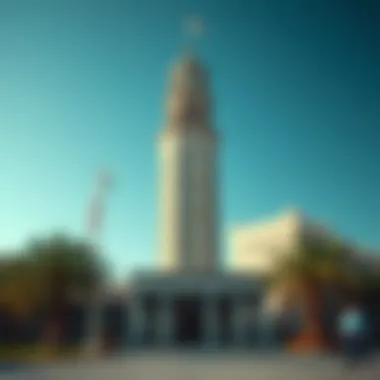

The Clock Tower's cultural significance transcends its physical form, inspiring artistic representations that echo its value within Dubai's narrative. Artists, poets, and filmmakers have drawn on its imposing presence to articulate themes of time, progress, and memory. It appears not only in local art galleries but also on social media platforms, often alongside hashtags that inspire conversations about Dubai's rapid transformation.
For instance, local artists may depict the Clock Tower in mural projects, using vibrant colors and styles that reflect both contemporary and traditional influences. It serves as a canvas for initiatives aimed at preserving Dubai's rich history, as well as celebrating its vibrant future. Literature and poetry, too, have found a muse in this emblem of time, invoking the essence of nostalgia and aspirations.
Additionally, the Clock Tower shows up in the ubiquitous world of social media, a favorite backdrop for Instagram photos that capture the essence of the city. Visitors can be seen posing with it, adding to a catalogue of digital memories, all echoing sentiments of connection to the place and its narrative.
In this way, the Clock Tower remains a crucial part of Dubai's cultural dialog, reflecting how a structure can inspire creativity and contribute to the ongoing narrative of a city constantly in flux.
Impact on Urban Development
The Clock Tower stands as a pivotal structure in the unfolding narrative of Dubai's urban landscape. Its significance goes beyond mere aesthetics or functionality; it is intertwined with the city's development strategies and urban planning. The role of the Clock Tower in shaping public spaces cannot be overstated. It acts not just as a marker in the skyline but also as a unifying element around which various urban activities converge.
Role in City Planning
In the grand tapestry of Dubai's urban planning, the Clock Tower is more than a decorative chronometer. It serves as a landmark that influences pedestrian patterns and traffic flow. City planners have leveraged its location to designate the surrounding area as a hub for retail, cultural, and civic engagement. By anchoring the surrounding locale, the Clock Tower effectively delineates public spaces, encouraging foot traffic and social interaction.
- Promoting Accessibility: The convenient location near major roads and public transit links makes it easily accessible for both residents and tourists, enhancing its role in the fabric of the city.
- Integration of Surrounding Areas: Being a focal point in various urban projects, the Clock Tower aids in the integration of different neighborhoods, fostering a sense of community and enhancing social interaction.
- Land Use Designation: As city planners map out new developments, the presence of the Clock Tower often guides zoning laws and land development regulations, ensuring any new structures harmonize with the historic character of the area.
Influence on Surrounding Infrastructure
The Clock Tower has significantly influenced the infrastructure surrounding it, serving both functional and symbolic purposes. As an urban marker, it necessitates investments in public amenities that enhance the area’s appeal and operational efficiency.
- Transport Networks: The presence of the Clock Tower has led to improvements in public transport accessibility, including bus routes and pedestrian pathways. This development fosters greater connectivity throughout the region.
- Public Spaces: The landscape around the tower has been thoughtfully designed to create green spaces and plazas that encourage recreational activities and community gatherings. With seating areas and art installations, these spaces promote leisure and cultural interactions.
- Architectural Cohesion: New buildings and infrastructure developments in the vicinity often reflect design philosophies that honor the older architecture of the Clock Tower, resulting in a coherent visual narrative across different eras of construction.
The presence of the Clock Tower in the urban milieu of Dubai injects a sense of identity and continuity, reminding residents and visitors alike of the city’s historical roots while inviting them to engage with its future.
In summary, the Clock Tower not only embodies the blend of tradition and modernity but also acts as a catalyst for strategic urban development and infrastructure progress in Dubai. Its integration into the city’s framework highlights its enduring relevance as both a marker of time and a cornerstone of community engagement.
Modern-Day Relevance
The Clock Tower stands not just as a remnant of the past, but as a vital part of Dubai's contemporary fabric. In an age where historical sites often find themselves overshadowed by rapid urbanization, this iconic structure has managed to hold its ground, showcasing the balance between heritage and progress. Its relevance today extends beyond mere nostalgia; it encapsulates essential elements that touch upon tourism, community identity, and urban planning.
Tourism and Visitor Engagement
Tourism serves as a lifeblood for Dubai, drawing millions to its shores every year. The Clock Tower is centrally located and can't be missed by visitors roaming through the city. It acts as more than just a photo opportunity—it's an engaging portal to Dubai's past. As tourists gather around it, there’s a rush of excitement to learn about its historical significance and architectural features.
Several tour companies include excursions that specifically feature the Clock Tower. These tours delve into its origins, explaining how it once served as a linchpin in connecting different parts of the burgeoning city. Visitors not only admire its impressive structure but also are introduced to the timeline of Dubai's development, fostering a deeper understanding of the socio-economic factors that drove growth.
Additionally, events hosted near the Clock Tower attract local and international tourists alike. From cultural festivals celebrating Emirati traditions to art fairs showcasing local creativity, the location is a hive of activity. Many find themselves snapping photos or simply enjoying the ambiance, ensuring that the Clock Tower remains a focal point in their travel experience.
- Key Engagement Strategies:
- Guided tours featuring the Clock Tower
- Cultural events and activities
- Interactive experiences and exhibitions
Integration with Contemporary Urban Life
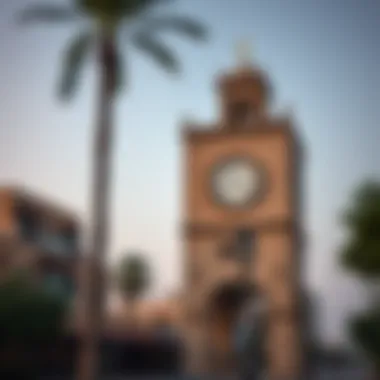

In today’s world, where modern life often seems disconnected from history, the Clock Tower acts as a geographical and symbolic anchor. Its presence integrates seamlessly with Dubai's cosmopolitan lifestyle, always reminding residents and visitors alike of the city's evolution over decades. The tower is surrounded by bustling marketplaces, modern skyscrapers, and arterial roadways, underscoring how old and new coexist.
Urban life around the Clock Tower showcases modern conveniences while promoting community welfare. Public parks and leisure spaces near the tower serve as gathering points where families enjoy weekends, thereby enhancing the area's social fabric. The proximity of cafes and restaurants allows local businesses to thrive and encourages spontaneous interactions among diverse groups of people.
Moreover, the Clock Tower is often featured in local art and media, embedding it into the daily lives of the city's residents. Photographers, artists, and even filmmakers frequently draw inspiration from its majestic shape and rich history. In a sense, the Clock Tower stands as a living monument, actively participating in the ongoing narrative of Dubai, despite the city's relentless forward momentum.
The Clock Tower is a testament to Dubai's journey, bridging the gap between a storied past and a vibrant future.
Thus, the Clock Tower is not just a historical landmark; it's a symbol of Dubai's enduring spirit, residing at the crossroads of time and modernity. As the city continues to evolve, so too does the relevance of this iconic structure, ensuring its place in the hearts and minds of those who encounter it.
Preservation Efforts
Preserving historical landmarks like the Clock Tower is not merely about keeping structures standing; it’s an ongoing commitment to preserving cultural identity, community values, and architectural heritage. The Clock Tower holds a significant position in Dubai's urban fabric. It reflects not only the historical context of the city but also its trajectory of growth and modernization. As Dubai evolves rapidly, so does the necessity to maintain such landmarks, ensuring that they continue to resonate with both residents and visitors.
Restoration Projects and Initiatives
Numerous restoration projects have been initiated with the aim of safeguarding the Clock Tower from the wear and tear of time and the bustling urban environment surrounding it. Key efforts include:
- Structural Reinforcement: Engineers undertake comprehensive assessments to ensure that the building’s integrity is not compromised by environmental changes or urban development nearby.
- Restoration of Facade: Artistic teams specialize in using traditional techniques to restore the Clock Tower’s exterior, ensuring that it retains its original charm while incorporating modern materials that blend seamlessly with the old.
- Public Engagement Initiatives: Programs are being implemented to involve the community in the process of preserving the clock tower, which foster a sense of ownership and pride among local residents.
Such initiatives not only enhance the visual appeal of the Clock Tower but also serve as educational platforms for the public, illuminating the history and significance of the structure.
Challenges in Maintaining Historical Structures
The task of maintaining a structure like the Clock Tower comes with its own share of hurdles. Despite the best intentions, several challenges manifest in the preservation process:
- Urban Development Pressures: With the city constantly evolving, pressures from modern construction can threaten the existence of historical landmarks. Architects often face dilemmas on how to integrate new infrastructures while respecting the integrity of the Clock Tower.
- Securing Funding: Restoration projects are often hampered by budget constraints. Securing necessary funding for long-term preservation can prove challenging, particularly as historical buildings compete with new developments for financial resources.
- Environmental Factors: Exposure to harsh weather conditions—being in the Arabian Peninsula—can exacerbate deterioration. Efforts must be taken to combat natural elements such as sandstorms and extreme heat, which might compromise the structure's longevity.
To address these issues, constant dialogue among city planners, preservationists, and the public is essential. Bonds between these stakeholders can forge strategies that protect not just the Clock Tower, but also the rich history it embodies.
"The preservation of historical landmarks like the Clock Tower is fundamental to a community's identity, serving as a bridge between the past and future of a city."
As Dubai moves forward, balancing development with a commitment to its history will prove vital for creating a sustainable urban environment. Well-thought-out preservation efforts will ensure that the Clock Tower continues to be a beacon of the city’s past while coexisting harmoniously with its daunting skyline.
Culmination
The conclusion encapsulates the multifaceted role of the Clock Tower in Dubai, serving as a historical anchor while embodying the city’s rapid modernization. It is vital to recognize that this structure is not merely a timepiece but a testament to the evolving identity of Dubai—a meeting point of tradition and contemporary urban life.
Summary of Key Insights
Throughout this article, we have explored various dimensions related to the Clock Tower:
- Historical Significance: Its origins and the story behind its construction reveal a connection to Dubai's past and cultural heritage. The clock is a constant reminder of the city’s journey from a humble fishing village to a thriving metropolis.
- Architectural Uniqueness: The distinctive design features that stand out in the skyline represent a blend of Arabic and modern architectural styles, emphasizing the artistic prowess involved in its making.
- Cultural Relevance: As a community landmark, it has facilitated gatherings, celebrations, and events, becoming an integral part of the daily lives of residents.
- Urban Development Impact: The Clock Tower has played a crucial role in shaping the urban landscape, influencing city planning and nearby infrastructure developments, thus reinforcing its position as a focal point in Dubai.
- Modern-Day Functionality: In the face of Dubai's fast-paced lifestyle, it continues to attract tourists and locals alike, integrating with the dynamic urban setting and adapting to contemporary needs while retaining its classic charm.
Future Prospects for the Clock Tower
Looking ahead, the prospects for the Clock Tower are promising yet challenging. There is a growing recognition of its importance not just as a historical monument but as a vital part of Dubai's identity. The following are key considerations for its future:
- Preservation Initiatives: Continued efforts to maintain and enhance the Clock Tower are crucial. It requires adequate funding and support from both public and private sectors to ensure it stands the test of time.
- Cultural Programming: Encouraging local artists to create works inspired by the Clock Tower could help rejuvenate interest and celebrate its significance in Dubai's artistic landscape.
- Integration with Urban Development: Future developments should take into account the Clock Tower's historical value, finding ways to enhance connectivity and visibility without overshadowing it.
- Tourism Initiatives: As tourism continues to be a backbone of Dubai’s economy, the Clock Tower could be part of a larger narrative that showcases the city’s history and its integration into the modern world.
Overall, the Clock Tower must be viewed as more than just an architectural feature; it is a symbol of time that has witnessed the evolution of Dubai and will continue to do so in the years to come.


